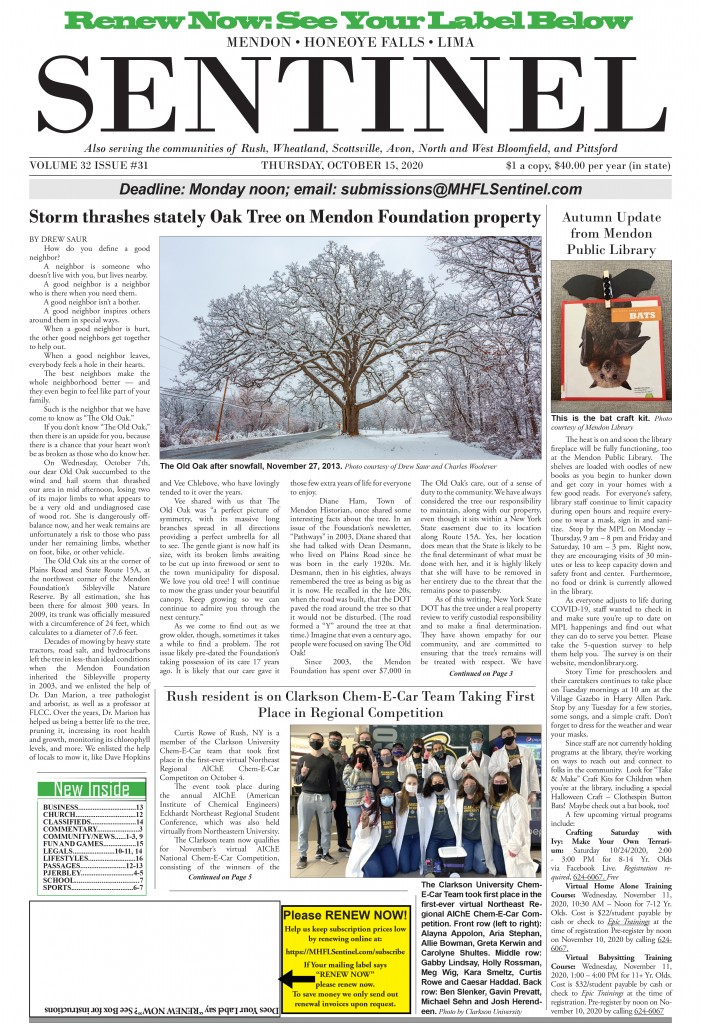 BY SKYLER, DEB & TIM SMITH
BY SKYLER, DEB & TIM SMITH
Man I was sweating bullets on this one. An interview with my boss . . . what could possibly go wrong? Screw this one up and the next thing I know I’m reassigned to writing obituaries. Talk about pressure. Today I’m riding high, on top of the literary world, and under Pulitzer consideration for authoring one of the most talked about breakthrough columns of the year. But fame can be fleeting; one minute I’m writing the Skyler Smith’s Tour of Mendon column and the next minute I’m doing Skyler Smith’s Tour of the Graveyard.
My boss Chris Carosa is a multi-talented individual who not only is the publisher of this newspaper, he is the portfolio manager of Carosa Stanton Asset Management. This firm, which recently celebrated its 20th anniversary, is a Registered Investment Adviser that manages the Bullfinch Fund, Inc., a Registered Investment Company containing two mutual funds (Unrestricted Series and Greater Western New York Series). In addition, the company manages portfolios for both individuals and institutions; primarily IRA Rollovers, taxable portfolios, and retirement plans. These are individually managed and separate from the Bullfinch Fund.
Great success is often preceded by a modest start. Mr. Carosa showed me a framed article hanging on his wall which was published in 1997 by the New York Times in what he referred to as “the most staid section, in the most staid edition, in the most staid newspaper in the country.” The Times was critical of Carosa Stanton stating that investing their assets in one of the most economically depressed areas of the country like western New York was certainly a recipe for disaster. Five years later after USA Today named the Bullfinch Fund Greater Western New York Series as the best performing fund in the nation, Mr. Carosa contacted the reporter that had written the Times article and asked him if he’d like to do a follow-up piece. Mr. Carosa has yet to hear back from him.
Carosa Stanton has achieved considerable success employing a philosophy using techniques derived from behavioral economics which maximizes growth potential while diminishing downside risk. Mr. Carosa and the late Gordon Stanton established the firm in late November of 1996. In 1997 the Bullfinch Fund was conceived and initiated.
Here’s one more story from the early days of the Bullfinch Fund. After initiating the fund, Mr. Carosa was in the position of having to convince investors to come on board with his company. He remembers talking to one man who asked him how his fund had performed, and Mr. Carosa told him it was up 10%. The man kicked Mr. Carosa out of his office pointing out that the stock market was up 20%. But the market turned at that point and when he ran into the man a year later the man asked Chris what he was doing to have the Bullfinch Fund up 10% while the market was down 10%. Mr. Carosa replied, “Exactly the same thing you kicked me out of your office for doing last year.”
The Western New York Fund is unique in that it invests only in companies that have a substantial presence in the 17 westernmost counties in New York State, including the Buffalo and Rochester areas. One might think that limiting investments to the economically struggling western New York region would be a doomed policy; here’s Mr. Carosa’s explanation on how they’ve been able to make this concept work.
“We are able to get to know the companies a lot better than you can with a company across the country,” Mr. Carosa said, “These are stocks in our own backyard. We are constantly inundated by the local press with the news on these stocks and we’re able to see superstar stocks before the rest of the industry sees them.”
After only a few years, the Bullfinch Fund attained a level of success that was quickly recognized by both the local and national press. I was given free rein to peruse the Carosa Stanton media archives and came across some articles which I thought did a good job of describing the firm’s success in layman’s terms. You don’t need to be a total expert in the stock market or have a degree in business to understand these next few tidbits I’m going to share with you.
On January 3, 2002, the Rochester Democrat & Chronicle published an article that stated, “Chances are that if you were invested in the stock market or owned mutual funds in 2001 you lost money. But there were a few exceptions including the Mendon based Bullfinch Fund.” The article goes on to state that while the Dow Jones was down 7.1% in 2001, Bullfinch Unrestricted and the Bullfinch Western NY Funds were up 16.7% and 17.7% respectively.
About a year later on January 11, 2004 the D & C ran another article stating, “And it was a happy year for holders of the Bullfinch Fund Western NY Series, a unique Mendon based mutual fund that invests only in companies that are either headquartered or have substantial operations in the Rochester and Buffalo areas.” The article went on to say that by appreciating 45.8% Bullfinch ranked 7th among 105 funds listed on Lipper’s website at the end of the year.
Listed in the March 1st 2004 issue of CBS MarketWatch were the “Top 100 Value Funds Based on Year to Date Return”. Not only is BWNYX fund on the list, it’s actually #1. How cool is that!?
The decade from 1999 – 2008 is sometimes referred to in the financial world as “The Lost Decade”. Here are some numbers that explain the use of that phrase to describe the time period, as well as a related tale about how some local folks did not get lost. During the Lost Decade the stock market in general declined 10% while the Bullfinch Fund rose 50%. Those numbers pretty much speak for themselves.
Carosa Stanton has continued to flourish throughout the second decade of the 21st century. This doesn’t surprise me; anytime Dad, Deb or I stop over we see a lot of hard work going on.
One of Carosa Stanton’s stated objectives is to help their clients achieve their individual Lifetime Dream. My Lifetime Dream in this article was to write something good enough to keep me from being relegated to the obit department.







